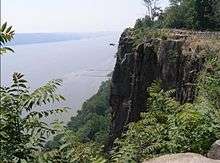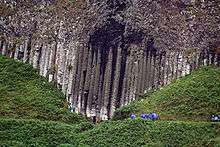Trap rock
Trap rock, also known as either trapp or trap, is any dark-colored, fine-grained, non-granitic intrusive or extrusive igneous rock. Types of trap rock include basalt, peridotite, diabase, and gabbro.[1] Trapp (trap) is also used to refer to flood (plateau) basalts, e.g. the Deccan Traps and Siberian Traps.[2] The erosion of trap rock created by the stacking of successive lava flows often created a distinct stairstep landscape from which the term "trap" was derived from the Swedish word "trappa", which means "stairway".[1]




The slow cooling of magma either as a sill or as a thick lava flow sometimes creates systematic vertical fractures within the resulting layer of trap rock. These fractures often form rock columns that are typically hexagonal, but also four- to eight-sided.[3][4]
Uses
Trap rock, i.e. basalt or diabase, has a variety of uses. A major use for basalt is crushed rock for road and housing construction in concrete, macadam, and paving stones. Because of its insensitivity to chemical influences, resistance to mechanical stress, high dry relative density, frost resistance, and sea water resistance, trap rock is used as ballast for railroad track bed and hydraulic engineering rock (riprap) in coast and bank protection for paving embankments. It is also used for the production of cast rock that is used in corrosion and abrasion protection, as for sewage pipes and acid-resistant rocks. Other uses of trap rock include gardening and landscaping, for the production of millstones, for the production of mineral fibres (basalt wool), as a flux in ceramic masses and glazes, for the production of glass ceramics, crushed as a filter aggregate (air filtration of poison gas in ABC bunkers), as filter bed material water treatment facilities, and ground as a soil improvement product.[5] Trap rock has been used to construct buildings and churches: Trinity Church on the Green with trap rock quarried from Eli Whitney's quarry, is a particularly colorful example of a red-orange-brown-colored, natural-faced trap rock. It was also used for foundations and railroad beds in the New Haven area.
Examples
Well-known examples of outcropping trap rock include both intrusive sills and extrusive lava flows. They include the Palisades Sill, a Triassic, 200 Ma diabase intrusion that forms the Palisades along 80 kilometers (50 mi) of the Hudson River in New York and New Jersey. Vast areas of trap rock in the form of thick lava flows and other volcanic rocks comprise the Deccan Traps of India and Siberian Traps of Russia.
See also
References
- Neuendorf, K.K.E., J.P. Mehl, Jr., and J.A. Jackson, J.A., eds. (2005) Glossary of Geology (5th ed.) American Geological Institute, Alexandria, Virginia. 779 pp. ISBN 978-0-922152-76-6
- Le Maitre, R. W., ed. (2002) Igneous Rocks: A Classification and Glossary of Terminology. Cambridge University Press, New York. 236 pp. ISBN 978-0-521-66215-4
- Muller, G. (1998) "Experimental simulation of basalt columns". Journal of Volcanology and Geothermal Research. vol. 86, no. 1–4, pp. 93–96
- Spry, A. (1962). "The origin of columnar jointing, particularly in basalt flows". Journal of the Geological Society of Australia. Vol. 5, pp. 191–216.
- Lorenz, W., and W. Gwosdz (2003). Manual on the Geological-technical Assessment of Mineral Construction Materials. Geological Yearbook Special Issue series H, issue SH15. Federal Institute for Geosciences and Natural Resources and the State geological surveys in the Federal Republic of Germany, Commission E. Hense (Naegele and Obermiller), Hanover, Germany. 497 pp. ISBN 3-510-95917-5.